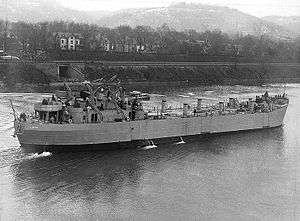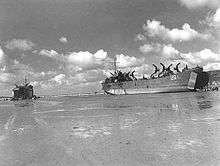USS LST-1
 LST-1 underway soon after completion c. December 1942 in the vicinity of Pittsburgh, Pennsylvania | |
| History | |
|---|---|
| Name: | USS LST-1 |
| Builder: | Dravo Corporation, Pittsburgh, Pennsylvania |
| Laid down: | 20 July 1942 |
| Launched: | 7 September 1942 |
| Commissioned: | 14 December 1942 |
| Decommissioned: | 21 May 1946 |
| Struck: | 19 June 1946 |
| Honours and awards: | 4 battle stars |
| Fate: | Sold for scrapping, 5 December 1947 |
| General characteristics | |
| Type: | Landing Ship, Tank (Mk.2) |
| Displacement: |
|
| Length: | 328 ft (100 m) |
| Beam: | 50 ft (15 m) |
| Draft: |
|
| Depth: | 8 ft (2.4 m) forward, 14 ft 4 in (4.37 m) aft (full load) |
| Propulsion: | 2 General Motors 12-567 diesel engines, two shafts, twin rudders |
| Speed: | 12 knots (22 km/h; 14 mph) |
| Boats & landing craft carried: | Two or six LCVPs |
| Troops: | 14-16 officers, 131-147 enlisted men |
| Complement: | 7-9 officers, 104-120 enlisted men |
| Armament: |
|
USS LST-1 was a tank landing ship (LST (2)) built for the United States Navy during World War II, the lead ship in her class of 390.
LST-1 was laid down on 20 July 1942 at Pittsburgh, Pennsylvania by the Dravo Corporation; launched on 7 September 1942; sponsored by Mrs. Laurence T. Haugen; and commissioned on 14 December 1942 with Lieutenant W. L. Chessman in command.
During World War II, LST-1 was assigned to the European Theater and participated in the following operations: Allied invasion of Sicily (July 1943); Salerno Landings (September 1943); Anzio-Nettuno phase of operations on the west coast of Italy (January to March 1944); and the Invasion of Normandy (June 1944).
LST-1 was decommissioned on 21 May 1946 and was struck from the Naval Vessel Register on 19 June 1946. On 5 December 1947 she was sold to the Ships Power and Equipment Company of Barber, New Jersey for scrapping.
LST-1 earned four battle stars for World War II service.
References
This article incorporates text from the public domain Dictionary of American Naval Fighting Ships.
- "LST-1". Dictionary of American Naval Fighting Ships. Retrieved 1 April 2007.
- "LST-1". Amphibious Photo Archive. Retrieved 1 April 2007.
See also
